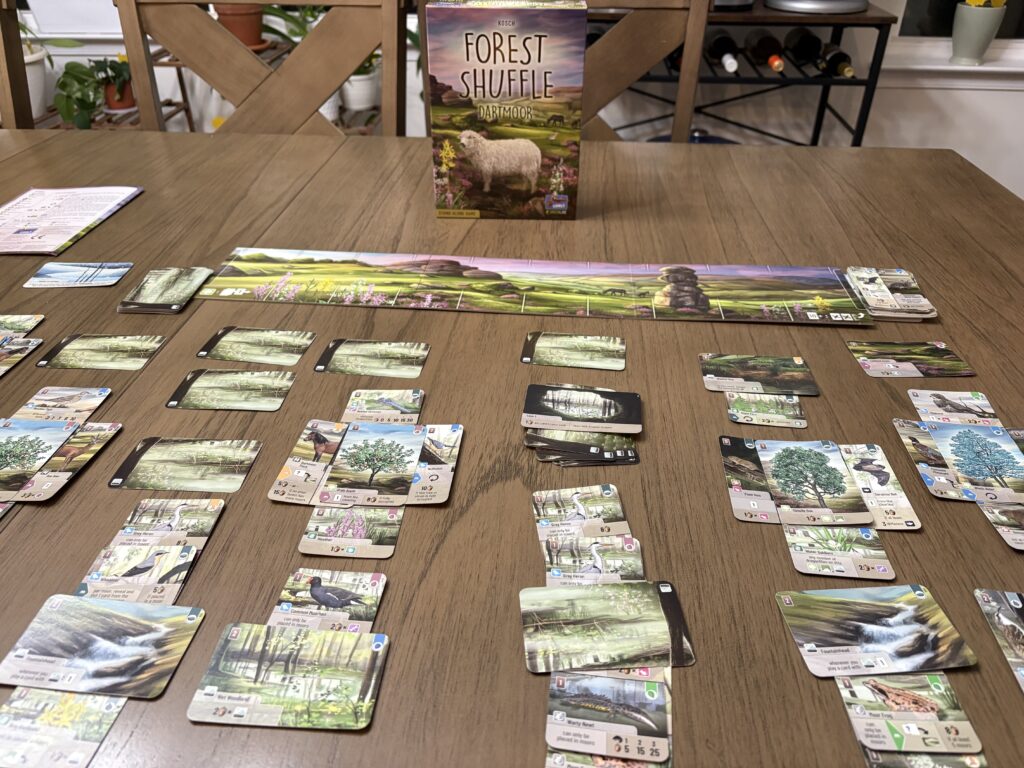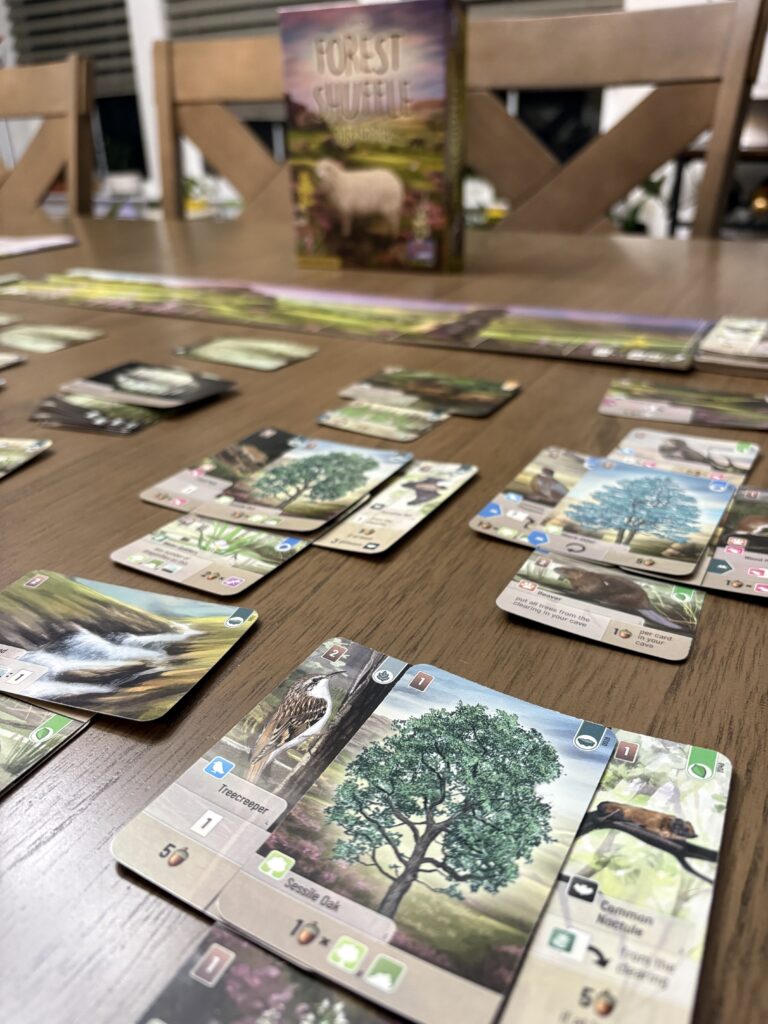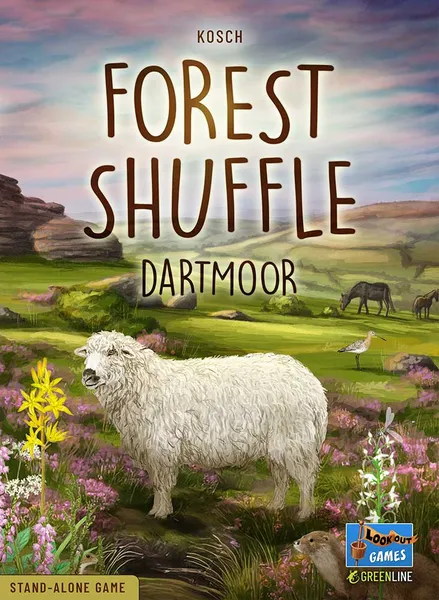Welcome to this week’s review! This week I’m taking a look at a recent sequel to a popular card, tableau-building game. So without further ado, let’s jump into it.
Disclosure: A review copy of this game was provided to The Meeple Digest in exchange for an honest, unbiased review. This review is not intended to be an endorsement.
Forest Shuffle: Dartmoor
- Designer: Kosch
- Publisher: Lookout Games
- Complexity: Light
- Time: 60 Minutes
- Players: 2-5
- Main Mechanisms: Card Tableau-Building
I have never played the original Forest Shuffle, but I was eager to try the recently released sequel – Forest Shuffle: Dartmoor. I generally had heard positive things about Forest Shuffle, and it seemed like a fairly light card, tableau-building game. Although I was aware the game may have had some balancing issues and that the scoring was a bit of a headache, I was curious to see if any of those concerns had been ironed out in the sequel.

While I haven’t played Forest Shuffle, the core changes to the formula in Dartmoor seem relatively minor, and based on the rulebook, there are only a couple of sections marked “new”. The first new addition is the introduction of caves that are drafted during setup. One example is that a player can draw and discard a few extra cards before their first turn, while another example provides a flat number of victory points at the end of the game. There are also few cards within the deck that interact with your cave, largely by adding cards to a stack where each card scores one victory point each at the end of the game. Overall, the caves seem like a fairly minor addition, and gamers looking for more asymmetries will likely be disappointed. The second new addition is the introduction of a new terrain type – moor. These function very similarly to other terrains in that you can put animals and plants above and below the terrain card, but there are some cards that can only be played into a moor.
If you’re new to Forest Shuffle, one of the more interesting mechanics in the game is the use of split cards. I’m a big fan of multi-use cards in games, as I feel they introduce a nice added layer of decision making. In Forest Shuffle, the split cards that can either be played on the top/bottom or left/right of other cards. These split cards have two different animals or plants on the same card, meaning you’ll only be able to play one of the two into your tableau. This also feels thematic in that birds are played on top of trees, while insects are played below them. Players can also discard cards of the matching type when playing a card to trigger an instant effect, introducing another layer of multi-use. It’s also important to note that cards have a cost to play them, which you do by discarding cards from your hand.
A modern tableau-building game wouldn’t be complete without card combos. In Forest Shuffle, it’s satisfying to build up an engine or combo multiple cards together for enhanced effects. Additionally, while you’ll likely want to specialize in certain types of cards, such as collecting sets of the same animal type, there are some nice synergies that cross over between types. For example, one type of bird scores based on the number of bats, while another plant scores based on the number of dragonflies. While you may start the game by focusing on a specific area, as you draw more cards, you’ll likely cross over to different types and open more strategies.

Up until this point, I’ve been relatively positive on the game, but I also have some key criticisms. First off, the game feels like it well overstays its welcome. Somewhere around the three-quarter mark, I’m ready for the game to end. By that point, I’ve managed to build up a large and unwieldly habitat that playing more cards has a diminishing return on my enjoyment.
Part of this issue is likely because of two factors. First is the dynamic nature of the endgame trigger. During setup, there are winter cards that are shuffled into the bottom third of the deck, and when all three are drawn, the game ends immediately. This can either lead to a quicker game where the winter cards are higher up the deck, or a longer game if the last winter card is towards the bottom of the deck. There were times when I was drawing cards with the hope of drawing the final winter card, just to speed the game up, which is never a good sign. The second factor that can lead to differing playtimes is the shared discard row. When you discard cards to play a card, the discarded cards go into a shared “clearing”. Other players, including yourself, can draw cards from the clearing instead of from the deck. This can lead to a scenario where players keep cycling through the same cards as they discard, draw from the clearing, and keep repeating without decreasing the size of the deck as quickly. There is a rule where if the clearing ever reaches at least ten cards, then all cards in the clearing are permanently discarded. This rule helps, but I don’t think it does enough to combat the lengthening of the game.
Speaking of the clearing, that’s really the only mechanism that introduces any real form of player interaction. In theory, you could analyze the other players’ habitats to figure out which cards from your hand they might be interested in and avoid discarding those. However, in practice, this doesn’t really happen because there gets to be a point where there are so many cards played, that this would become way too time consuming. This would also dramatically lengthen the game and introduce unwanted analysis paralysis. Therefore, there is barely any player interaction, which is why I would never choose to play Forest Shuffle with over three players.
As with most of these types of games, Forest Shuffle has its fair share of card luck. If you’re focused on a strategy that requires a certain type of card, or you’re trying to collect a set of the same type of animals, say dragonflies, it can feel frustrating when you keep drawing the wrong cards. In addition, since there are so many types of cards, it can be difficult to combo them together because one card can often require a specific type of other card to gain its benefit. Therefore, some turns may feel wasteful if you don’t end up drawing the right cards at the right time. One could argue that the clearing offers some luck mitigation because at least if another player draws the card you want, they could discard it into the clearing, and then you would have a chance to draw it.
Another slight critique is that I wish the rules were a bit clearer. The rulebook is fairly small, but a lot of that is down to the appendix being online, rather than a printed copy within the box. I wish I said that I didn’t have to reference it often, but especially for the first few games, I did find myself occasionally checking the appendix to clarify some of the less obvious card effects. All this leads to not wanting to pull this game out to teach to newer gamers and would lean towards other gateway games to turn to first.
Finally, I wish I could say the scoring process was fixed in Dartmoor, but it was still a bit of a nightmare to tally up. I’ll admit, after finishing my first game, I looked down at the plethora of cards in front of me, turned to my wife, and said something along the lines “Are we sure we want to count these?” Going back to my point about the game feeling like it overstays its welcome, if the game was a bit shorter, I think that could help ease the scoring procedure because there would be fewer cards to count.
Personally, the positives in Forest Shuffle: Dartmoor don’t outweigh my issues with the game. Maybe I could look past the flaws if the game was shorter, but it’s hard for me to see myself picking this game off the shelf anytime soon. I have many other tableau building games in my collection that I prefer, and if I’m looking for something lighter, there are games that have a much shorter playing time. If someone asked me to play Forest Shuffle, I’d probably oblige, as long as it’s with no more than three players, but unfortunately, Forest Shuffle: Dartmoor will not be remaining in my collection.
With that, I’ll wrap up this week’s review! If you’ve played Forest Shuffle and/or Dartmoor, I’d love to hear your thoughts on the games? And what are your favorite card, tableau games? I’d love to hear your thoughts on any of the games I’ve mentioned or future content suggestions in the comments below. Happy gaming!
If you liked this post and want to be notified when new content is released, then follow me on Instagram @themeepledigest.

Leave a Reply